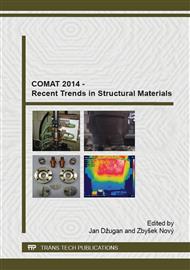p.85
p.91
p.99
p.107
p.113
p.121
p.127
p.135
p.143
Background of Branched Crack Formation in Surface Zone of Continuously-Cast Ti-Nb Microalloyed Steel Slab
Abstract:
Branched cracks are undesirable and dangerous, and under the oxidized surface of a continuously-cast slab they are mostly difficult to identify. They can cause the formation of defects in thick sheet or on thin strip. This work deals with the study of the background to the formation of branched cracks in a continuously-cast slab, at pulling rate 0.43 m.min-1. The results of the work show that branched cracks extended to a depth of 10 mm below the slab surface and occurred mostly below oscillation marks. Cracks were mostly present in the edge parts of the slab, where they were also deeper in comparison with locations in the middle of the slab width. Microstructural analysis confirmed heterogeneity of ferrite grain sizes in the slab surface skin. The microstructure was formed predominantly of polyhedral ferritic-pearlitic grains, and on the ferritic grain boundaries the presence of tertiary cementite was observed. In the area around the cracks mainly non-equilibrium microstructure of acicular character was observed. A typical feature of these cracks after their opening is intercrystalline fracture. Wavelength-dispersive X-ray analysis of a sample with a branched crack showed chemical heterogeneity of harmful elements, mainly S and As. Large amounts of these elements point to their significant segregation. The formation of branched cracks is conditioned not only by segregation of impurities, but possibly also by the presence of undesirable brittle cementite networks. The presence of cementite was confirmed not only by microstructural analysis, but also diffraction of hard X-ray radiation. Precipitation of microalloying elements in connection with the cementite can lead to higher probability of surface crack formation, as also confirmed in this study.Keywords: slab, branched cracks, oscillation marks, segregation, precipitation
Info:
Periodical:
Pages:
143-149
Citation:
Online since:
October 2015
Keywords:
Price:
Сopyright:
© 2015 Trans Tech Publications Ltd. All Rights Reserved
Share:
Citation:


